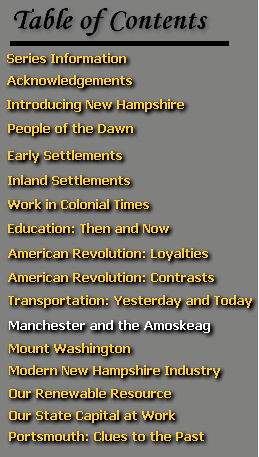SUMMARY
 This
lesson describes the Industrial Revolution in New Hampshire and its impact
on one specific area, Manchester. This
lesson describes the Industrial Revolution in New Hampshire and its impact
on one specific area, Manchester.
The mills of Manchester's
Amoskeag Manufacturing Company, once one of the largest textile factories
in the world, served as a model of planning and progress to the industrialized
world. The Amoskeag Factories got their name from the Amoskeag Falls. Amoskeag,
in the language of the Penacook Indians, meant "to take small fish." This
is what the Indians did when they lived along the banks of this river near
the falls. They named the river Merrimack, which means "place of strong
current."
Shortly after the American
Revolution, another revolution swept through England, then Europe and the
United States. In this revolution, the weapons were not guns, but machines.
The invention of carding and spinning machines brought about the industrial
revolution in the English textile industry. The first large-scale textile
factories were built during the late 1700s in Manchester, England. Machines
did the work once done by human hands. Greater volume of goods could be
manufactured. A product was made in one place, the factory. Each factory
worker did one task in the process.
The most dramatic example
of the Industrial Revolution in New Hampshire occurred in Manchester, with
the development of Amoskeag Mills. In 1809, the Amoskeag Cotton & Wool
Manufacturing Company was formed. At first, there were no looms and cotton
and wool were woven in local homes. Weavers earned 30¢ per day. In
1839, the Amoskeag Manufacturing Company was formed by six men. The New
Hampshire legislature appropriated $1 million to further develop this company.
Mills were built and machines were installed.
Manchester was designed and
built by the company's owners. Aspects of their community plan were: (1)
all machines and tools needed were made at the site in a foundry and machine
shop built by the company; (2) bricks used to build the mills came from
the company brickyard; (3) a city was planned parallel and perpendicular
to the river; and (4) special provisions were made for employees.
The fact that there were
frequent injuries and deaths in the mills points out the cruel realities
of the Industrial Revolution. There were long hours, and child labor was
common.
During the Civil War, there
was a scarcity of Southern-grown cotton, so Amoskeag turned its production
to making 25,000 muskets for the war. After the war, Amoskeag prospered.
By 1912, the mills produced 50 miles of woven cloth per hour. Various people
worked in the mills. The first workers came from farms in New Hampshire.
As the need for labor increased, the company lured French Canadians, then
Greek, German, Swedish and Polish immigrants in the early l900s. Women
comprised half of the work force.
Threatened by cheap labor
in the South, Amoskeag officials increased hours, and decreased pay. In
1922, the workers called a strike, idling the mills for nine months. Workers,
out of economic necessity, had to go back to work without winning concessions.
The economic situation became worse because of the Depression of the 1930s.
On Christmas Eve, 1935, the mills closed. The industry that had sustained
the city for a century were gone.
The last yard of cotton was
woven in Manchester in March, 1975.
OBJECTIVES
1. To show the effect
of the Industrial Revolution on New Hampshire as seen through its impact
on one area--Manchester.
2. To help students
understand how ways of earning a living were changed by the Industrial
Revolution.
3. To help students
understand the influence an industry or company can have on a community.
4. To increase student
awareness of the long history of the Amoskeag Mills.
5. To make students
aware of economic and geographic factors that may influence a company's
development.
6. To build an understanding
of Manchester's present status based on a knowledge of the city's past.
PRE-VIEWING ACTIVITIES
1. Discuss with students
the ways in which people earn their living in their community. What factories
are located in the community?
2. List the differences
involved in producing goods by hand and through the factory system. Review
the class discussion following "Work In Colonial Times."
3. Define the term
"life-style." Have students comment on their "life-styles."
4. Locate Manchester,
Concord, and the Merrimack River on a map.
5. Discuss: what does
revolution mean? What was the American Revolution? What do you think the
Industrial Revolution was?
POST-VIEWING ACTIVITIES
1. Pretend that you
live in colonial times. State how you obtained your goods and clothing
and housing. Describe how you might have earned a livelihood.
2. Do further research
into the history of Manchester and the development of the Amoskeag Manufacturing
Company.
3. Pretend that you
were a New Hampshire farmer. Dramatize your feelings about leaving the
farm and going to work in "the city."
4. Invite people to
class who have worked in the Amoskeag Mills or in factories in your community.
Have them discuss their jobs and work experiences.
5. Dramatize a possible
job in a factory system. State how you might feel about doing one job over
and over again in the overall manufacturing process. What are the advantages
and disadvantages of such a system?
6. Imagine that you're
a young worker in the Amoskeag Mill in the 1850s or 1860s. Write a letter
to a friend in another city, describing the good and bad points of your
job in the mill. How would you like working 12 hours a day? Would you like
to live so close to the mill? What do you think of the benefits the company
provided?
7. What was the role
of women during the Industrial Revolution? Discuss the impact of working
women on the economy. What effect might the working woman have had on the
family unit?
8. Why might ethnic
groups leave their home area to work in a factory? Brainstorm a list of
reasons for moving from a home area.
9. Build a model of
the city of Manchester. Demonstrate the relationship of Amoskeag Mills
to the city in this model.
10. As an employed
worker, what conditions might cause you to strike? Write up a list of grievances.
Have a spokesperson present these grievances to the class.
11. Write a newspaper
headline and article describing the closing of the Amoskeag Mills.
12. Review what happened
to the factory buildings in Manchester after the Amoskeag Company closed.
Are there mills in your town that have been converted to other uses? Should
old factory buildings be preserved? Why or why not?
13. Arrange a field
trip to a factory in or near your town.
14. Design, as a class,
a model city. How would people earn a living? What provisions would you
make for employees? What long-range plans would you have for your city?
What other considerations should go into the design?
VOCABULARY
-
Amoskeag
-
carding
-
foundry
-
Merrimack
-
spinning
-
labor
-
Industrial Revolution
-
loom
-
strike
-
division of labor
-
canal
-
Depression
-
specialization
-
lock
-
economy
PLACES TO KNOW
-
Amoskeag Falls
-
Merrimack River
-
Lowell, Mass.
-
Manchester
-
Concord
PEOPLE TO KNOW
-
Penacook Indians
-
spinner
-
Germans
-
Samuel Blodgett
-
weaver
-
Swedes
-
factory worker
-
Poles
-
carpenter
-
French-Canadians
-
blacksmith
-
Greeks
IMPORTANT DATES
| Late
1700s |
First large-scale textile
factories built, Manchester, England. |
| 1809 |
Amoskeag Cotton &
Wool Mfg. Company formed in Manchester. |
| 1839 |
Amoskeag Manufacturing
Company formed; state appropriation received. |
1839-1914 |
Amoskeag Mfg. Company
following developmental plan devised by company owners. |
| 1851 |
Amoskeag wins prize at
Worlds Fair. |
1861-1865 |
Amoskeag makes muskets
for Civil War. |
| By
1870 |
15,000 French-Canadians
in Manchester. |
| 1912 |
Amoskeag produces 50
miles of woven cloth per hour. |
Early
1900s |
Greek, German, Swedish,
Polish immigrants arrive in Manchester. |
| 1922 |
Workers strike. |
| 1935 |
Mills close. |
| 1975 |
Last yard of cotton woven
in Manchester. |
WEB RESOURCES
|




